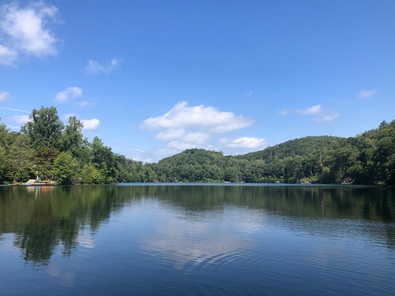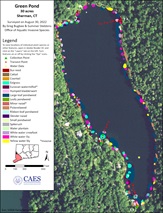Green Pond, Sherman - 2022
2022 Aquatic Plant Survey of Green Pond
Green Pond is a 30-acre waterbody located in Sherman, CT. It is a private pond with a maximum depth of approximately 35 feet.
CAES IAPP performed its first survey of Green Pond in August 2022. Eighteen aquatic plant species were found, including two invasive species. Invasive Eurasian watermilfoil (Myriophyllum spicatum) was found frequently around the lake and has been actively managed since 2014 using diver-harvesting and benthic blankets. Minor naiad (Najas minor) was the other invasive species found in the lake. It was found by the beach in the north end and in a few locations along the western side of the pond. Minor naiad is an annual plant that regrows each year from the previous year’s seed. Thus, it is not normally noticeable until early to mid-summer when it grows in patches in the shallows. It often is most abundant in and around beaches. CAES IAPP is not aware of any control practices be performed on this plant in Connecticut apparently because it is not a nuisance. If management in beach areas is desired, it can easily be removed with a rake.
Vegetation occurred frequently throughout the lake within 150 feet of the shoreline at depths to 10 feet due to above average transparency (Secchi = 16.4 feet). The mostly commonly found species were native pickerelweed (Pontederia cordata), large-leaf pondweed (Potamogeton amplifolius), eelgrass (Vallisneria americana), and invasive Eurasian watermilfoil. White water lily (Nymphaea odorata) and yellow water lily (Nuphar variegata) were also common. The primary nuisance species were Eurasian watermilfoil and large-leaf pondweed which occurred on 47% and 37% of the transect points respectively. These plants often reached the surface, at sparse to moderate densities that would be a nuisance to swimmers. Fisherman might prefer these locations as they are a habitat for bass, pickerel, and other species. Many trees have fallen into the lake that also offer fish habitat.
Aquatic plant management is currently being accomplished by the installation of numerous benthic blankets. Many of these appear to have been installed in a year prior to our survey. This has allowed sediment to gather on the barrier and vegetative growth to begin. CAES IAPP has demonstrated the barriers can be installed and removed in as little a month for season long control. We suggest that the barriers be placed in one spot for no more than one season.
An herbicide application using a new product called ProcellaCOR® is being considered. The product has been shown to be extremely effective at giving multiyear control of watermilfoil while leaving many native species such as large-leaf pondweed relatively unscathed. Whether this approach is feasible for Green Pond will be dependent on CT DEEP/Town review, stakeholder acceptance, and affordability. Pondweeds, particularly large-leaf pondweed, might fill the void left by the removal of Eurasian watermilfoil and become a greater nuisance.
|
Species recorded during our 2022 survey of Green Pond. |
||
| Bur-reed | Large-leaf pondweed | Small pondweed |
| Cattail | Leafy pondweed | Spikerush |
| Coontail | Minor naiad* | Water plantain |
| Eelgrass | Pickerelweed | White water crowfoot |
| Eurasian watermilfoil* | Ribbon-leaf pondweed | White water lily |
| Humped bladderwort | Slender naiad | Yellow water lily |



